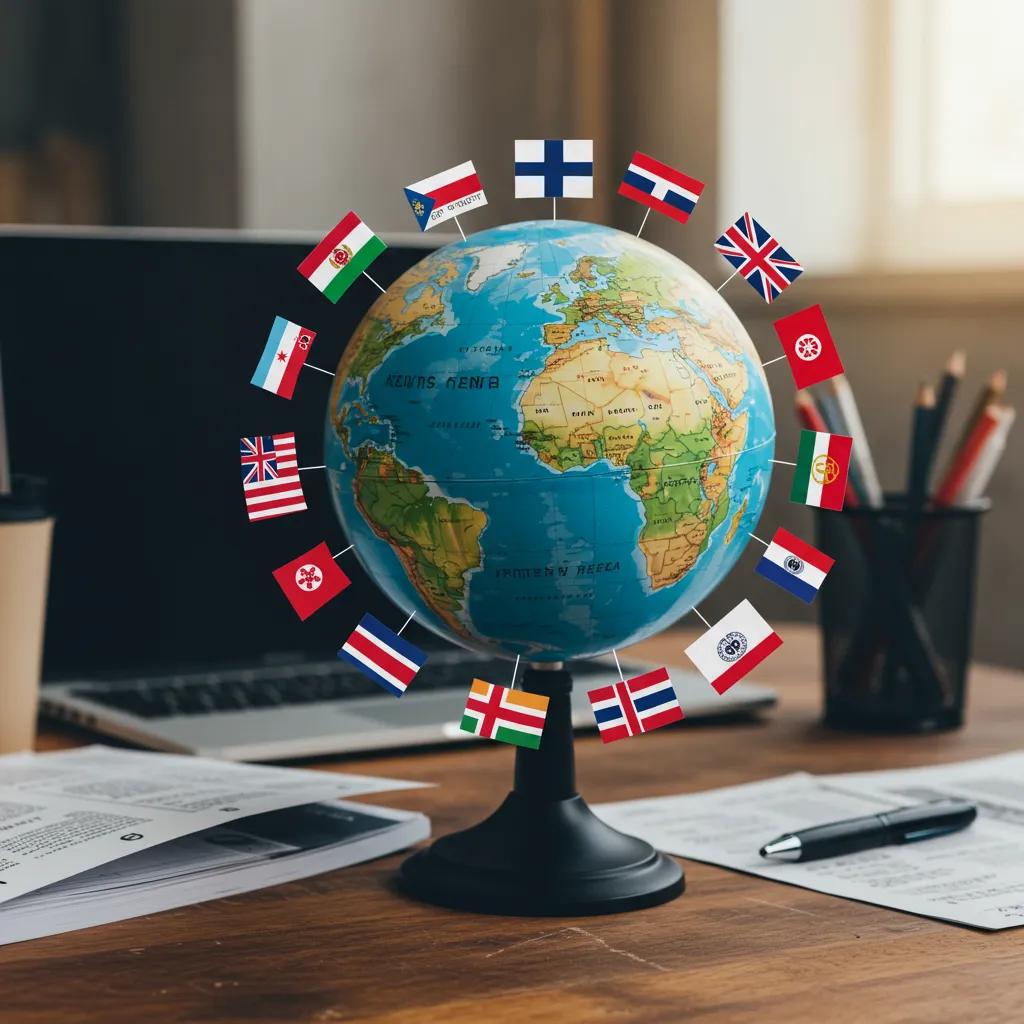Understanding Translation Service Costs: Key Factors for Smart Budgeting

The price of translation services can fluctuate significantly due to several interconnected elements, making precise budgeting crucial for both businesses and individuals. In 2025, you can expect average rates to fall between $0.08 and $0.30 per word. However, grasping the core pricing factors will empower you to estimate your total expenses with greater accuracy. This guide delves into the primary translation pricing models, explores how the rarity of language pairs and the complexity of your documents influence costs, and examines specialized services like certified translation and machine translation post-editing. You'll also find practical advice on how to manage your budget effectively, identify potential hidden fees, harness the power of cost-saving technologies, and stay informed about industry trends for up-to-date rate benchmarks.
This article will cover:
- Common pricing structures, from per-word to project-based approaches.
- How your chosen source-to-target language combinations affect per-word pricing.
- Key cost drivers include subject matter, document formatting, and turnaround time.
- Fees associated with certified translations and notarization services.
- How MTPE, CAT tools, and translation memory can reduce your overall expenses.
- Actionable budgeting tips, common hidden costs to watch out for, and effective quote calculators.
- Benchmark data and regional rate variations as of October 2025.
What Are the Standard Ways Translation Services Charge?

Translation pricing models are the frameworks service providers use to calculate their fees, ensuring clients have a clear understanding of what they're paying for. The most common models—per-word, hourly/per-page, and flat/project-based—each cater to different types of projects and client needs. Your choice of model will depend on the volume and complexity of your content, as well as your desired level of project management.
Many service providers also incorporate minimum charges or package deals to accommodate projects of all sizes. By understanding the nuances of each model, you'll be better equipped to compare quotes and ensure the pricing aligns perfectly with your project's scope and timeline.
How Does Per-Word Pricing Work for Translation?
Per-word pricing is the most common method in the industry, with translation services typically costing between $0.08 and $0.30 per word. This model calculates the fee based on the word count of the source text, applying a rate that takes into account factors like language pair rarity, the required specialization, and the desired quality tier.
Professional translators often use specialized software for precise word counts, while agencies might apply a minimum word count—usually between 50 and 200 words—to cover project setup costs.
Typical per-word pricing tiers include:
- Standard Content for common language pairs, priced at $0.10–$0.20 per word
- Technical or Legal Texts, which command higher rates of $0.15–$0.35 per word
- High-Volume Projects, often eligible for volume discounts of 10–20 percent
These tiered rates allow clients to find a balance between cost and the level of expertise required, making per-word pricing a transparent and adaptable solution for most translation needs.
When Are Hourly and Per-Page Rates Used?
Hourly and per-page rates are typically applied when a simple word count doesn't fully capture the scope of the work involved, such as for tasks like proofreading, editing, or desktop publishing. Hourly fees, generally ranging from $30 to $100 per hour, cover specialized activities like intricate layout formatting, in-depth terminology research, or interpretation services. Per-page rates, which can range from $20 to $100 per page, are often used for certified translations and documents with complex formatting, including tables, graphics, or extensive desktop publishing requirements.
Service providers estimate hourly rates by calculating the time needed for project management, quality assurance checks, and final review processes. Per-page pricing offers a simplified billing structure for clients with documents of consistent length, particularly in legal, medical, and academic fields, ensuring all formatting and certification requirements are accounted for.
What Are Flat-Rate and Project-Based Pricing Options?
Flat-rate or project-based pricing consolidates all services into a single, upfront fee. This approach is ideal for projects like website localization, marketing campaigns, or extensive documentation. Providers determine this fee by evaluating the project's overall scope, the necessary resources, and the required turnaround time. Project-based fees can range widely, from $500 to $10,000 or more, depending on the total word count, the number of target languages, and the project's complexity.
Common flat-rate packages include:
- Website Localization, covering content analysis, translation, and quality assurance, is typically priced from $0.15–$0.50 per word equivalent.
- E-learning Modules, which may include voice-over, subtitling, and content adaptation, often cost between $1,500–$5,000 per course.
- Software UI Translation, including string testing and pseudo-localization, usually ranges from $1,000–$3,000 per project.
By bundling services, project-based pricing provides budget predictability and simplifies the invoicing process for multifaceted translation endeavors.
How Do Language Pairs Influence Translation Expenses?

The specific language pair you need translated directly impacts the cost due to variations in translator availability, market demand, and linguistic complexity. For common pairs like English to Spanish, there's a large pool of translators, resulting in per-word rates typically between $0.10 and $0.20. Conversely, rare pairs such as Icelandic to Thai require highly specialized linguists with niche expertise, leading to higher rates, often ranging from $0.25 to $0.40 per word.
When choosing a translation provider, understanding the rarity of your language pair and the associated price premium is essential for accurate budgeting. A rarer language pair may also involve longer vendor onboarding times and fewer quality assurance options, further influencing the overall cost.
This table clearly illustrates how the rarity of a language pair correlates with per-word rates, helping you anticipate necessary budget adjustments based on your source and target languages. Understanding these rate differences is a key step before considering other pricing factors like subject matter and turnaround time.
What Are the Typical Per-Word Rates for Common vs. Rare Language Pairs?
For common language pairs, average per-word rates generally range from $0.08 to $0.20. This is largely due to the high availability of translators and established, standardized translation processes. Rare language pairs, however, typically command rates between $0.20 and $0.40 per word. This higher cost reflects the limited pool of qualified linguists, the specialized training required, and the often more rigorous quality assurance steps needed to ensure accuracy.
Why Do Rare Language Combinations Lead to Higher Translation Prices?
Rare language combinations drive up translation prices primarily because the specialized linguistic expertise required demands extensive training, and there are fewer available translators. This scarcity naturally leads to higher per-word rates. Additionally, these projects often incur extra fees for project coordination, specialized vendor recruitment, and extended revision cycles to guarantee accuracy when working with less common language pairs.
What Factors Affect the Complexity and Cost of Translation Projects?
The complexity and overall cost of a translation project increase with factors such as the subject matter of the document, the file formatting, and the urgency of the deadline. Specialized content, like legal contracts, medical reports, or technical manuals, necessitates translators with specific domain expertise, typically resulting in rates from $0.15 to $0.50 per word. Intricate formatting for materials such as brochures, spreadsheets, or presentations adds desktop publishing (DTP) costs, which can range from $30 to $100 per hour. Furthermore, tight turnaround times may incur a rush surcharge, often adding 20–50 percent to the base price.
Carefully considering these factors will help you create a more accurate budget and avoid unexpected charges.
How Does the Document's Subject Matter Impact Translation Pricing?
The subject matter of a document significantly influences pricing because specialized texts require translators who possess relevant certifications and in-depth knowledge of the field. Legal and medical documents, for instance, often incur rates of $0.15–$0.50 per word, reflecting the higher stakes and the rigorous quality assurance protocols involved. Technical manuals for engineering or scientific publications might cost between $0.20–$0.45 per word, due to the need for precise terminology management and stringent accuracy checks.
What Role Do Formatting and File Type Play in Translation Costs?
Formatting and file type play a crucial role in the overall cost, as complex layouts, charts, and embedded graphics require specialized desktop publishing (DTP) skills. Translators or DTP specialists typically charge between $30 and $100 per hour to meticulously recreate original design elements in the target language. Documents formatted in software like InDesign, FrameMaker, or PowerPoint often incur these hourly DTP fees in addition to the base translation rates, ensuring the final output perfectly matches the source document's appearance.
How Does Urgency Affect Translation Fees and Rush Charges?
Project urgency directly impacts translation fees through rush surcharges, which can add 20–50 percent to the base rates for projects requiring completion in less than 24–48 hours. Meeting these accelerated deadlines often necessitates securing additional translator capacity, expediting review processes, and extending vendor working hours. Clients requesting overnight or weekend deliveries should anticipate these premium pricing structures to accommodate the accelerated workflow.
What Are the Costs and Benefits of Certified Translation Services?
Certified translation services come at a higher cost but provide legally recognized documents essential for official purposes. These certified translations typically range from $20 to $100 per page, with the final price influenced by the language pair and the document's subject matter. Notarization, when required for official seals, adds an additional $10–$50 per document. These services guarantee compliance with regulatory standards and include affidavits or certification statements required by courts, immigration authorities, and government agencies.
Opting for certified translation ensures the validity of your documents and minimizes the risk of rejection in critical applications.
How Much Does Certified Translation Typically Cost Per Page?
Certified translation generally costs between $20 and $100 per page. This price range can vary based on the language pair, the complexity of the content, and the specific type of certification needed. Simpler personal documents usually fall at the lower end of this scale, while technical certificates or detailed legal transcripts may require higher rates to cover the specialized translator fees and thorough quality assurance processes.
When Is Notarization Required and How Does It Affect Pricing?
Notarization is typically required when documents need an official seal to authenticate the translator’s affidavit or certification statement. Notary fees generally range from $10 to $50 per document, depending on state regulations and notary availability. Including notarization ensures that your certified translations are readily accepted by courts, government bodies, and educational institutions without the need for further validation.
How Do Advanced Translation Technologies Impact Pricing?
Advanced translation technologies streamline workflows and reduce costs by automating repetitive tasks and effectively reusing previously translated content. Machine Translation Post-Editing (MTPE) combines raw machine output with human review, potentially lowering per-word rates to $0.04–$0.15 while maintaining high quality. CAT tools and translation memory can decrease the amount of new content requiring translation by 10–30 percent, thereby reducing overall project costs through the efficient reuse of translated segments.
Integrating these technologies not only speeds up delivery times but also ensures consistent terminology across all your translated materials.
What Is Machine Translation Post-Editing (MTPE) and Its Pricing Model?
Machine Translation Post-Editing (MTPE) involves human review and correction of machine-generated translations, offering a balance between speed and accuracy. The pricing for MTPE typically falls between $0.04 and $0.15 per word. This rate depends on the quality of the initial machine output and the level of editing required, ranging from light edits for basic clarity to comprehensive reviews for publication-ready content.
MTPE Pricing Models: An Analysis for Translation Services
Machine translation post-editing (MTPE) has become a significant component of the commercial translation industry. This study addresses the complex issue of MTPE remuneration by first analyzing the pricing models currently employed within the industry. Subsequently, it examines Language Service Providers' (LSPs) MTPE pricing models as a practical framework for understanding the implications for translators.
In search of a fair MTPE pricing model: LSPs' reflections and the implications for translators, A Sakamoto, 2024
How Do CAT Tools and Translation Memory Reduce Translation Costs?
CAT tools and translation memory significantly reduce costs by creating a database of translated segments that can be reused in future projects. When identical or similar phrases and sentences appear, translators can leverage these existing translations instead of starting from scratch. This process can decrease the volume of new text needing translation by 10–30 percent, leading to direct cost savings and ensuring consistent terminology across large or recurring content updates.
How Can You Obtain an Accurate Translation Quote and Manage Your Budget?
To secure an accurate translation quote, you'll need to provide detailed project specifications, including the word count, language pair, subject matter, file type, and desired deadline. Be sure to clearly state any specific formatting or certification requirements upfront to avoid unexpected charges. Requesting itemized quotes that break down costs for base translation, DTP, rush fees, and certification will enhance transparency.
Maintaining a clear budget involves anticipating potential additional expenses and comparing estimates from multiple vendors.
What Hidden Costs Should You Be Aware of in Translation Projects?
Be vigilant for potential hidden costs such as minimum service fees for small projects, charges for vendor onboarding, fees for glossary creation, additional rounds of revisions beyond what's included, and expenses for file conversion. These ancillary fees can surface after a project begins if the scope isn't clearly defined initially, so it's crucial to clarify all potential add-ons during the initial quote negotiation phase.
What Tips Can Help Reduce Translation Expenses Without Compromising Quality?
Optimize your approach to reduce translation expenses by:
- Consolidating repetitive content to maximize translation memory savings.
- Providing clean, editable files to minimize the time spent on DTP.
- Requesting volume discounts for large-scale or ongoing projects.
- Scheduling non-urgent work during standard delivery periods.
By refining your project inputs, you can effectively lower costs while upholding the highest standards of translation quality.
How to Use Translation Cost Calculators Effectively?
Translation cost calculators provide estimated expenses by applying your project parameters—such as word count, language pair, and urgency—to standard rate tables. Inputting precise document metrics and service options will help generate reliable budget forecasts. While these calculators offer valuable ballpark figures, it's always recommended to request detailed quotes for final pricing to account for specific complexities and certification needs.
What Are the Current Industry Trends and Average Translation Rates in 2025?
As of 2025, the global translation market is valued at over $75 billion, with average professional rates hovering between $0.08 and $0.30 per word. The demand for specialized services, particularly in legal, medical, and technical fields, continues to drive premium rates, often ranging from $0.15 to $0.50 per word. The increasing adoption of MTPE and advanced CAT tool integration has significantly boosted workflow efficiency, enabling service providers to offer competitive pricing and faster turnaround times.
Emerging trends include more granular regional pricing variations, a deeper focus on niche specializations, and continued growth in certified and notarized services to meet international compliance requirements.
What Are Typical Per-Word Rates Across Different Languages and Specializations?
In 2025, typical per-word rates vary based on language and specialization:
- English–Spanish: $0.10–$0.20
- English–German: $0.12–$0.22
- Technical/Engineering: $0.18–$0.35
- Medical/Pharmaceutical: $0.20–$0.45
- Legal/Patent: $0.25–$0.50
How Do Regional Pricing Variations Affect Translation Costs Globally?
Regional pricing variations are influenced by local labor costs, currency exchange rates, and market demand. Rates in North America often fall at the higher end of global averages, while translators in Eastern Europe and Asia may offer more competitive pricing. Understanding these geographic differences allows you to tap into international talent pools for cost optimization without compromising the quality of your translations.
Incorporating regional rate differences into your translation budgeting can lead to substantial savings while ensuring professional standards are consistently met.
Planning your translation budget becomes much more manageable when you break down costs by pricing model, language pair, complexity, and technology utilization. By anticipating potential hidden fees and leveraging cost-saving tools, you can secure accurate quotes and maintain firm control over your translation expenses. Continuously monitoring 2025 rate trends and regional variations will equip you to negotiate competitive pricing and make informed investments in your multilingual content strategy.








